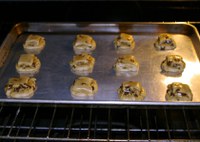Prairie Fare: Just One Lick of Batter Could Make You Sick
(Click an image below to view a high-resolution image that can be downloaded)
By Julie Garden-Robinson, Food and Nutrition Specialist
NDSU Extension Service
While in college, I had a friend who preferred raw cookie dough to baked cookies. Once in a while, she’d make a batch of chocolate chip cookie dough and keep it in the refrigerator as a snack.
She seemed to have stomach aches and flulike symptoms more often than other people I knew. I suspected her cookie dough habit might have played a role. I wasn’t a food safety specialist back then, and I wasn’t trying to be her mother.
You may be tempted to taste cookie dough and cake batter. Kids may compete for the opportunity to lick the beaters or the mixing bowl after the cook has made a cake or cookies.
According to a national campaign message from the Partnership for Food Safety Education at http://www.fightbac.org, “just a lick can make you sick.” No one of any age should eat raw cookie dough or cake batter because it could contain germs that cause illness.
The cookie dough in ice cream or other commercial desserts is made with pasteurized eggs, so it is safe to eat. However, the cookie dough in ready-to-bake rolls or the dough sold as preformed cookies needs to be baked.
The heat from baking is required to kill germs that might be in the raw ingredients. The finished, baked product is far safer and tastes even better. Remember that kids who eat raw cookie dough and cake batter are at greater risk of getting food poisoning than most adults are.
Which ingredients and germs are we most concerned about? Cookie dough and cake batter usually contain raw eggs, which may be contaminated with salmonella.
Salmonella is the most common bacterial cause of foodborne illness. Raw and undercooked eggs, undercooked poultry and meat, fresh fruits and vegetables, and unpasteurized dairy products also have been linked with salmonella outbreaks.
Often, cross-contamination in the kitchen can lead to the contamination of other foods. For example, if you did not clean the mixing bowl or beaters properly and then you made ready-to-eat frosting, you could have contaminated frosting. That’s a good reason to wash all your kitchen utensils and bowls thoroughly.
So, what is the risk to you if you want to lick some beaters? You cannot see, taste or smell salmonella. As with speeding on the highway or crossing the street without looking both ways, sometimes you are lucky and nothing happens.
However, about 2 million to 4 million cases of salmonellosis (the illness associated with salmonella infections) occur yearly in the U.S., and the number of cases has risen in the past decade. Salmonellosis causes symptoms such as nausea, vomiting, cramps, diarrhea, fever and headaches. The acute symptoms may last two days or longer, depending on the amount of the food you ate, the strain of salmonella and how susceptible you are.
Scientists now know that salmonellosis may have long-range effects, including reactive arthritis.
As with all types of foodborne illness, anyone can be affected. However, the very young and old, and those with compromised immune systems are most at risk.
Here’s a cookie recipe courtesy of the Oregon State University Cooperative Extension Service. It features pumpkin, which is one of the hallmarks of fall. Although the cookie dough might be tempting, be sure to bake before eating. Right after mixing, drop the beaters into soapy water to deter taste testers in your kitchen. You can begin with fresh, mashed pumpkin or use canned pumpkin.
For more information about nutrition and food safety, visit http://www.ag.ndsu.edu/food.
Pumpkin Cookies
1 can pureed pumpkin (without added spice)
1 1/2 c. brown sugar
2 eggs
1/2 c. canola or sunflower oil
1 1/2 c. flour
1 1/4 c. whole-wheat flour
1 Tbsp. baking powder
2 tsp. cinnamon
1 tsp. nutmeg
1/2 tsp. salt
1/4 tsp. ground ginger
1 c. raisins or dried cranberries
1 c. chopped walnuts
Preheat the oven to 400 F. Mix pumpkin, brown sugar, eggs and oil thoroughly. Blend dry ingredients and add to pumpkin mixture. Add raisins and nuts. Drop by teaspoonfuls on a greased cookie sheet. Bake for 10 to 12 minutes or until golden brown.
Makes 48 cookies. Each cookie has 90 calories, 4 grams (g) of fat, 13 g of carbohydrate, 2 g of protein, 1 g of fiber and 60 milligrams of sodium.
(Julie Garden-Robinson, Ph.D., R.D., L.R.D., is a North Dakota State University Extension Service food and nutrition specialist and professor in the Department of Health, Nutrition and Exercise Sciences.)
NDSU Agriculture Communication – Sept. 19, 2013
| Source: | Julie Garden-Robinson, (701) 231-7187, julie.garden-robinson@ndsu.edu |
|---|---|
| Editor: | Rich Mattern, (701) 231-6136, richard.mattern@ndsu.edu |



